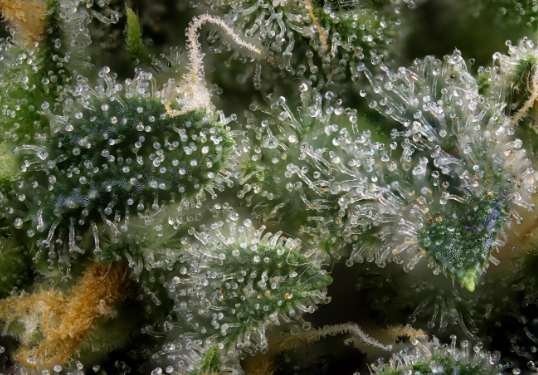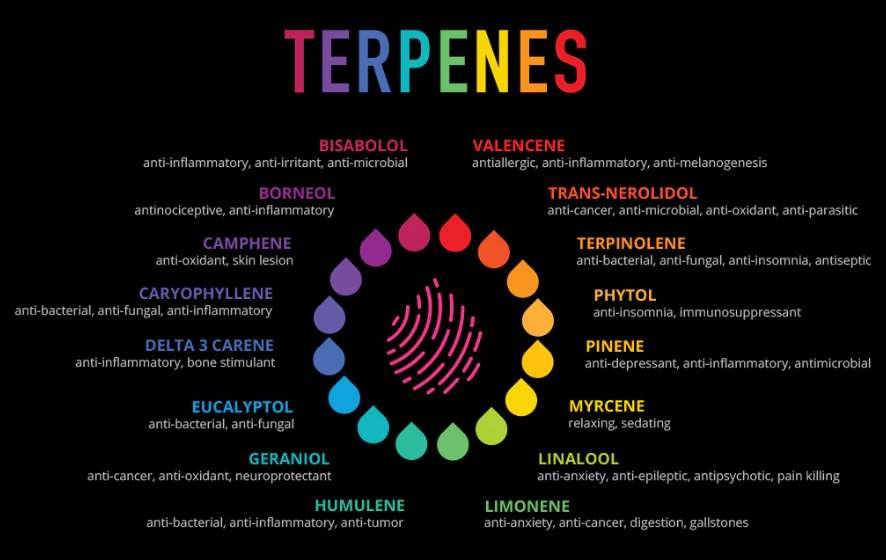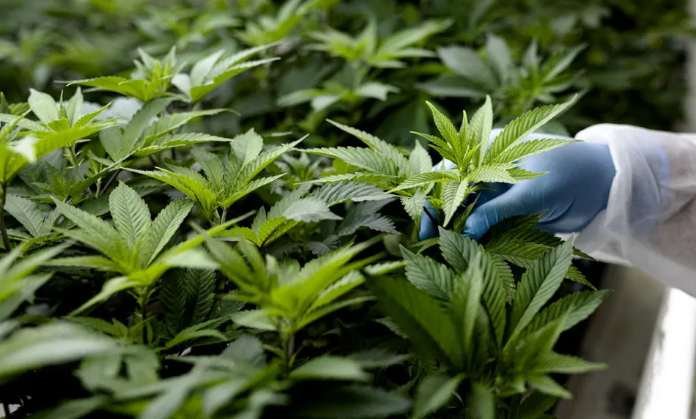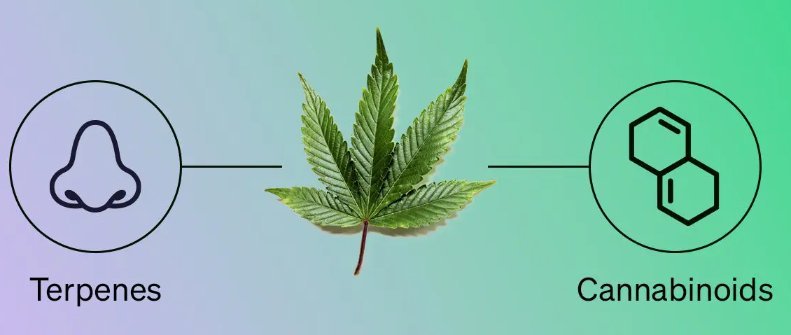If you are tired of buying cannabis products that don’t give you the desired effects or flavor? If so, then it might be time to start considering the role of cannabis in users’ purchasing desires. In this article, we are covering all the most important aspects of this useful product. We are all also a study of Tarpenes and have gathered all useful information on these molecules in cannabis. It may also enhance a user’s high and the psychoactive effects of the plant. Our goal is to provide all users with the knowledge that they need to personalize their cannabis experience according to their individual needs and circumstances.
What are Tarpenes?
Tarpenes are also called Terps. They are a class of organic compounds. They are found in many plants and they are also including cannabis. These compounds are responsible for the distinct smells and flavors of different plants as well. If any user has likely encountered this plant before without even realizing them. Then their pleasant aroma of lavender, the refreshing scent of pine, and the citrusy scent of oranges are all thanks to this organic factor.
But these organic compounds do more than give any plants their signature scents. These organic compounds also serve important functions for the plants that they may produce them. In some cases, they can act as natural repellants. They are helping keep pests and diseases away. In other cases, they can attract beneficial insects and animals. They are also helping the plant spread its pollen and seeds as well.
They can also have a range of effects on humans and other animals. Some organic compounds are known to have medicinal properties. They are often used in producing essential oils and other natural remedies for human health. For instance, the terpene limonene is found in citrus fruits, and it is known for its stress-relieving properties.
But the most well-known use of this organic compound is that it is found in the cannabis plant. Cannabis plants may produce a wide variety of them, and each has its own unique set of effects.
What are Cannabis Derived Tarpenes (CDT)?
Cannabis may be derived from Tarpenes (CDT). They are a class of aromatic compounds. They are found in the trichomes of cannabis plants. These trichomes are very small, crystal-like structures that cover the leaves and buds of the plant. They may also contain a range of compounds, including cannabinoids like tetrahydrocannabinol (THC) and cannabidiol (CBD), as well as CDT.
CDT mixed fruity aroma:
The mix of CDT gives each cannabis strain its unique smell and flavor. It is largely responsible for why we would choose one over another fruit in our food items. For example, some strains have a piney or some may have an earthy scent. While others strains may have a more citrusy or fruity aroma as well.
It has some anti-inflammatory properties. While others may help to improve mood and promote relaxation in humans. When we combined the compounds found in cannabis, then there such as THC and CBD. It can have a large range of different effects on the body and mind as well.
Why should we pay attention to CBD Tarpene’s profile?
(CDT) has some potential effects on the body and mind. When we have consumed. There is so much research available and they suggest that these organic compounds may play a significant role in the overall effects of cannabis.
More research has shown that there are different compound profiles. And they can alter the absorption, distribution, and metabolism of cannabinoids. They are also leading to different effects on the body and mind.
Terpene myrcene:
For example, it has been shown and increases the permeability of the blood-brain barrier. This can also allow more THC to reach the brain and potentially. It also increases the psychoactive effects of the cannabinoid. It can have independent effects on the body and mind too.
Benefits of Tarpenes supported by Research:

There is so much research into the therapeutic benefits of this organic compound. This is still in the early stages. It may take a while to get some concrete evidence. But many studies suggest that they have a lot of promise and deserve more attention to grow more.
Most CDTs have similar effects on human bodies, although each one is unique and important. Some of the methods have many compounds and seem to benefit the body, and they are including:
Anxiolytic Benefits of Tarpenes:
There are some CDT that may help with depression and anxiety. They are used in combination with cannabinoids (THC and CBD).
Antimicrobial Benefits of Tarpenes
Many studies have found that there are so many compounds that have antimicrobial properties. They are including antibacterial, antiviral, antifungal, antimalarial, and antiparasitic traits, etc.
Analgesic Benefits of Tarpenes:
Some studies show that it may be able to reduce pain and may contribute to the powerful effects of cannabis.
Anti-inflammatory Benefits
Some study shows that it has shown several effects and it may have the ability to reduce inflammation, including neuro and respiratory inflammation. This also can help with certain types of pain and discomfort.
Neuroprotective Benefits:
Some CDTs may be able to protect the brain from harmful elements like oxidative stress and inflammation etc.
14 Most Common Tarpenes in Cannabis and Their Effects

1: Bisabolol:
Aroma:
It has a floral and also has sweet aroma.
Other sources:
Chamomile and Candeia.
Therapeutic value:
The study has shown that it has anti-inflammatory and skin-soothing properties. This may also have potential antibacterial and antioxidant effects.
Common Strains:
Some common strains are ACDC, Master Kush, Rockstar, Headband, and Pink Kush.
2: Beta-Caryophyllene:
Aroma:
It has a spicy and peppery aroma.
Other sources:
Black pepper, cinnamon, and hops.
Therapeutic value:
The study has shown that it may have potential anti-inflammatory and analgesic effects. It may also have the effects of antidepressant and anxiolytic effects.
Common Strains:
Bubba Kush, Death Star, Giri scour Cookies, Permafrost, White widow
3: Delta-3-Carene:
Aroma:
It has a woody, pine-like fragrance.
Other sources:
Pine, Cedar, and Cypress plants.
Therapeutic value:
It has potent anti-inflammatory and analgesic effects. It may also have broncho-dilating properties. Also, It is making it to possible for asthma treatment.
Common Strains:
Super Lemon Haze, Super Silver Haze, Skunk No. 1
4: Eucalyptol:
Aroma:
It has a fresh, woody, and slightly sweet aroma.
Other sources:
Eucalyptus and Bay leaves.
Therapeutic value:
It has potent anti-inflammatory and analgesic effects. This may also have antibacterial and antioxidant properties.
Common Strains:
Super Silver Haze, Bubba Kush, Chemdawa, and Headband
5: Geraniol:
Aroma:
It has a sweet and floral scent.
Other sources:
Roses, Geraniums, and Lemongrass.
Therapeutic value:
It has potential insect-repellent properties. It also has anti-inflammatory and analgesic effects.
Common Strains:
Amnesia Haze, Afghani, Master Kush, Headband.
6: Humulene
Aroma:
It has an earthy, woody, and slightly spicy aroma.
Other sources:
Hops, Basil, and Sage plants.
Therapeutic value:
This also has potent anti-inflammatory and analgesic effects. This may also have antibacterial and appetite-suppressing properties.
Common Strains:
Sour Diesel, Corilla Glue, Kush, Permafrost, and White Widow.
7: Limonene
Aroma:
This has a citrusy aroma.
Other sources:
Lemons, Oranges, and Limes.
Therapeutic value:
This has potential anxiolytic and antidepressant effects. This also has anti-inflammatory and immune-boosting properties.
Common Strains:
Durban Poison. Sour Diocol, Bruce Banner, OG Kush, and Trainwreck.
8: Linalool
Aroma:
It has a floral, lavender-like aroma.
Other sources:
Lavender, Basil, and Mint.
Therapeutic value:
It has potential anxiolytic and antidepressant effects. It may also have sedative and anti-inflammatory properties.
Common strains:
Amnesia maze, Blueberry, Master Kush, Pink Kush, Lavender Kush, Skywalker OG.
9: Myrcene
Aroma:
It has an earthy and musky aroma.
Other sources:
Mangoes, Hops, and Thyme.
Therapeutic value:
It has potential sedative and analgesic effects. It may also increase the absorption of THC. Also, It may increase the potential and enhance its psychoactive effects.
Common strains:
Death star, Northern lights, White Rhino, Blue Dream, and Cannatonic.
10: Ocimene
Aroma:
It has a sweet and floral aroma.
Other sources:
Mint, Basil, and Marjoram.
Therapeutic value:
It has potent antiviral and antimicrobial effects. This may also have anti-inflammatory and skin-soothing properties.
Common Strains:
Strawberry Cough, Himalayan Gold, Lemon Diesel, and OG Kush.
11: Pinene
Aroma:
It has a woody and pine-like aroma.
Other sources:
Pine trees and Rosemary plants.
Therapeutic value:
This may have alerting and memory-enhancing effects. They may also have broncho-dilating effects. They are making potential treatments for asthma.
Common strains:
Jack Herer, Strawberry cough, OG Kush, Permafrost, Trainwreck, and White Widow.
12: Terpineol
Aroma:
It has a floral and pine-like aroma.
Other sources:
Pine and Lilac.
Therapeutic value:
It has potential sedative and anxiolytic effects. It also has anti-inflammatory and antioxidant properties.
Common Strains:
Jack Herer, Girl Scout Cookies, OG Kush, and white widow.
13: Terpinolene
Aroma:
It has a woody and floral scent.
Other sources:
Tea trees, Pine, and Nutmeg.
Therapeutic value:
It has potent antioxidant and anti-inflammatory effects and it may also have some sedative properties.
Common Strains:
Jack Herer. Purple Haze and Critical Kush.
14: Valencene
Aroma:
It has a citrusy aroma.
Other sources:
Oranges and Tangerines.
Therapeutic value:
It has potential insect-repellent properties. This may also have anti-inflammatory effects.
Common strains:
Tangie and Lemon skunk.
How to identify the Tarpenes in cannabis products?

There are a few different ways to identify this organic product in particular cannabis are:
Lab testing:
There are so many cannabis products and they are tested in a laboratory to determine their chemical profile. This information is often included on every product label and is also available on the company’s website.
Aroma:
The aroma of a cannabis product of Tarpenes can be a good indicator of its chemical structure. Different organic compounds may have some distinctive aromas, and they are by paying attention to the smell of a product. We can get a sense of what they may contain.
Customer reviews:
Customers who have used this particular cannabis product. They may be able to provide some information about its chemical structure and they are based on their experience with the product.
Tips for selecting products with specific Tarpenes?
If we are looking for products with specific CDT profiles, here are a few tips to help us select the right product:
1: Search for products that have been lab tested:
There are so many products that have been tested in a laboratory. They are more likely to have accurate information about their structure.
2: Pay more attention to the aroma of Terpenes:
The aroma of a product can give us a sense of which CDTs it is and what they contain. To find a product with a specific CDT profile, we can search for products with an aroma and then they match the desired product as well.
Read customer reviews first about Tarpenes:
Many customers give their reviews and they can be a good source of information about them. They are looking for a particular product. So, we should look for reviews and then mention the aroma and effects of the product.
Ask the retailer or manufacturer always:
If we are unsure about them and it’s a particular product. Then we can always ask the retailer or manufacturer for more information about it. They may be able to provide us with more detailed information about the product.
How to use Tarpenes with Cannabis Products?
There are various ways to use this product in different forms of cannabis products. Let’s explore the most common ways.
Vaporized Terpenes:
This is one of the healthiest ways to consume it, is through vaporization. However, not just any method will do – this is the best way to experience some vaporized terps, and is through cold vaping or adding to it to e-liquids for vape pens.
Using a cold vape allows us to test the flavor and aroma of each product before adding them to the user’s products. This method of consumption has the added benefit of avoiding some combustion. This is as opposed to smoking which could produce harmful byproducts and increase the risk of negative health consequences as well.
Dry Buds (Flower)
It can enhance the effects of dry cannabis buds or flowers. It may be consumed through smoking or vaporizing the flowers. This product can either improve the already present effects of the flower or revitalize a subpar flower.
To use this product, with dry buds or flowers, add 1-2 drops of terpene oil per gram of flower.
CBD Distillate:
It can be added to distillates to restore some plants. They are lost during the distillation process. By adding this product to the distillate, we can recreate the desired flavor and effects of the original plant as well.
We can use a dabber or a magnetic stirrer to mix it and we can easily mix it into the distillate thoroughly and allow the mixture to infuse overnight before using.
CBD Concentrates:
To improve the flavor of cannabis and its concentrates that do not accurately reflect their strain, we can add this product mix to them. This is especially effective if this product is correctly matched to the strain.
To use this product and with concentrates, it may also allow adding 1-5% of the total weight. It is a good rule of thumb is to start with 2% and add more as needed.
CBD Tinctures:
It has the most unflavored CBD tinctures and they are bitter. This product may add flavor and they may enhance the taste and smell of CBD tinctures. They also improve the absorption and effects of CBD in the body. To find the ideal blend of this product, for our tinctures, we must consider our tastes, desired mood, and desired effects.
Tarpenes in Edibles and Drinks
It can be added to edibles and drinks to create dishes and cocktails. They are truly surprising. Because these products are entirely cannabinoid-free, we can make psychoactive-free edibles while maintaining multiple beneficial properties.
When we are using these products and we are added to cannabis-infused edibles. Then it is a healthy option to consume cannabis, and have with the potential to complement the effects of major cannabinoids. It is also allowing all the users to experience a more desirable high.
Tarpenes in CBD Oils:
Some products can be added to CBD or THC oils to enhance specific effects. For example, the presence of this product and shown to increase the absorption of THC and potentially increase its psychoactive effects.
It is the easiest way to add this product to oils. It is to use a syringe or a dropper for precision. Alternatively, we can add a small amount of this product to isolate each CBD oil dosage. It is best to start slowly and gradually increase the number of products if needed. For example, the user can start with a 1% concentration and see how his body reacts before increasing the amount of this product as shown.
Guidelines for Safe Tarpenes Consumption

There are various forms of using these products, such as sprays, prefilled cartridges, concentrates, and more. To consume this product safely, it is crucial to follow some general safety guidelines here.
1: Never consume pure products:
The pure product can be very concentrated. It may have some adverse reactions if they are consumed undiluted. We should always follow the recommended dosages and dilution ratios for the specific product.
2: Start with minimum amounts:
When consuming this product, it is best to start with small amounts. After then gradually increase the dosage as needed. This will help user to gauge how their body reacts to this product and they may avoid any adverse effects.
3: Mix appropriately:
When using this organic product in marijuana products, it is always important to remember that they are not water-soluble. So, we should try to use a carrier agent such as coconut oil, vegetable oil, or glycerin to mix them properly. This may ensure that this product is properly dispersed and ready for use.
4: Know our source:
It’s important to be aware of the source of this product that we may consume. To avoid purchasing such contaminated or poor-quality products, then we should make sure to only purchase from reputable sources.
5: Understand the effects:
The different products can have unique effects on the human body. So it’s important to be aware of the all possible effects of the product. We are consuming. So, we should conduct our research to understand the potential impact of different effects on the body.
6: Be cautious with medication
If any user is taking any medication, then it’s important to be cautious when consuming this product. Some CDTs may interact with certain medications. So, it’s vital to consult with a healthcare professional or your doctor before adding this product to your diet plan.
Most Frequently Asked Questions (FAQs)
1: What do Tarpenes react with?
Ans: In some plants, it may attract pollinators, while in other plants, they are causing a strong reaction to repel predators, such as insects or foraging animals, etc.
2: Can bacteria produce Terpenes?
Ans: Tarpenes are generally considered to be plant or fungal metabolites effect. Although, it has a small number of odoriferous of bacterial origin. They may have been known for many years.
3: Do all plants produce Terpenes?
Ans: Probably yes, all plants may have synthesized a suite of several hundred terpenoid compounds and they may be combined with roles that include phytohormones, protein modification reagents, anti-oxidants, and many more.
4: Do all fruits have Terpenes?
Ans: They are naturally found in many plants as well. It is making sense that there are contained in some of our food. Mangoes, Apples, Citrus Fruits, several Spices, Broccoli, and Beer all contain Tarpenes.
5: Which Tarpenes make us hungry?
This organic compound is thought to increase our appetite:
Myrcene:
They are found in thyme, parsley, bay leaf, mango, and lemongrass, Myrcene has musky, herbal, clove, and citrus aromas.
Caryophyllene:
They are found in clovers, black pepper, basil, and oregano, Caryophyllene has spicy, peppery, and woody aromas.
The Final Words:
Tarpenes are much of a natural and organic source material in our daily routine food. This compound may increase our health goodness. This product may also include in every little food item in our life.




